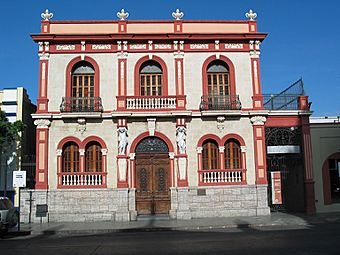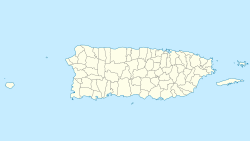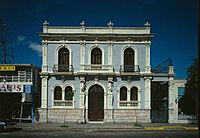Residencia Armstrong-Poventud facts for kids
Quick facts for kids |
|
|
Armstrong-Toro House
|
|

Residencia Armstrong-Poventud in August 2010
|
|
| Location | 9 Calle Unión, Ponce, Puerto Rico |
|---|---|
| Area | less than one acre |
| Built | 1899 |
| Architect | Manuel V. Domenech |
| Architectural style | Neoclassical |
| NRHP reference No. | 87001821 |
| Added to NRHP | 29 October 1987 |
| Established | 1991 |
|---|---|
| Location | Calle Union No. 9, western side of the street, facing the Ponce Cathedral, Ponce, Puerto Rico |
| Type | Museum |
| Owner | ICP, Commonwealth of Puerto Rico, San Juan, Puerto Rico |
The Residencia Armstrong-Poventud is a very old and important building in Ponce, Puerto Rico. It stands right across from the main church, the Catedral Nuestra Señora de Guadalupe. This house was so grand that it inspired many other beautiful homes built in Ponce around the year 1900. Its special style is part of what is called Ponce Creole architecture.
A famous architect named Manuel V. Domenech designed and built this home for the Armstrong-Poventud family. It is officially listed on the U.S. National Register of Historic Places as the Armstrong-Toro House. People also know it as the Casa de las Cariatides, which means "House of the Caryatids." Since 1991, the Instituto de Cultura Puertorriqueña (Institute of Puerto Rican Culture) has managed the house as a museum.
Contents
Building the Armstrong-Poventud House
The Institute of Puerto Rican Culture (ICP) and the Puerto Rico Office of Historical Preservation say the house was built in 1899. A magazine called American Architect and Building News even showed its design on its cover in January 1899.
The house first opened for visitors as a museum in 1991. At that time, it also served as the southern office for the Institute of Puerto Rican Culture. In October 2008, it officially became a full museum. Today, the museum also has a small shop where visitors can buy different items.
Why This House Is Special
The Armstrong-Toro Residence is one of the most famous houses in Ponce. It was designed by Manuel Domenech, a very important architect from the late 1800s and early 1900s. He also designed other famous buildings like the Asilo De Pobres in Mayaguez and the Residencia Batiz. Domenech was a well-known public figure who built many homes and public buildings in cities like San Juan, Ponce, and Mayaguez.
Carlos Armstrong-Toro: A Key Figure
Mr. Carlos Armstrong-Toro was also a very important person in Ponce. His father was a merchant from St. Croix. Carlos Armstrong-Toro became one of the first bankers in Puerto Rico. He started the Banco de Ponce and the Banco Crédito y Ahorro Ponceño. He even created an international banking network with offices in Puerto Rico, Cuba, the United States, and Denmark. Because of his strong connections with the Danish government, he received a high honor called the "Order of the Dannebrog" and became the Danish Consul to Puerto Rico.
Architectural Importance
The Armstrong-Toro Residence is very important for Ponce's history of architecture. It is one of Domenech's most unique designs and probably his most famous. Its special main entrance has caryatids, which are statues of women used as columns. The house also has many detailed decorations. Its location, right across from the Cathedral and the main public square (Plaza Las Delicias), makes it a true landmark. Because of this house, many other homes built in the early 1900s in Ponce copied its style. This helped create the unique historic district of Ponce.
What the House Looks Like
The Residencia Armstrong-Poventud is a two-story building made of stone. It is on the west side of Calle Union, right in front of the Cathedral and Plaza in the historic center of Ponce. The front of the house is almost square and has three main sections. The middle section is narrower and holds the main entrance.
Ground Floor Details
At the bottom, a pink stone base supports the building. It also supports the two caryatid statues that stand on each side of the main entrance. These statues help divide the front of the house into its three sections. The main entrance is an arch that cuts into the stone base. It has beautifully carved wooden doors and a stained-glass window above them. Decorative iron railings protect this window. The other two sections on the ground floor have pairs of arched windows with folding wooden shutters.
Upper Floor Details
On the upper floor, there are four tall, decorative columns with bases. These columns rest on a continuous stone line. The three openings on this floor are evenly spaced and look similar. Each has a simple frame with a keystone and a wide arch. These arches open to balconies through wooden doors. Above each opening, there is clear glass with decorative designs. The balconies on the first and third sections have decorative cast-iron railings. The wider central balcony has stone railings supported by the caryatid statues from the ground floor. The top of the house has a decorative cornice and a solid wall. Roman-style vases on this wall act as decorations above each column.
Side and Inside Features
On the north side of the house, a concrete covered driveway extends from the upper floor. This creates a side terrace on the second floor.
The house has a simple layout but is built very elegantly. When you enter, you step into a small hall. From there, wooden and stained-glass double-doors lead to the main hallway. A grand staircase at the back of the house on the left side leads to the second floor. The second floor has a similar layout to the first. All the floors inside the house are made of parquet wood. The ceilings are made of pressed metal with hand-painted designs. The parquet floors were added during a recent restoration, but the pressed-metal ceilings are original.
After a big earthquake in 1918, the northern wall of the house fell down. It was rebuilt exactly as it was originally designed. The concrete covered driveway was added at that time. Other than this addition, the Armstrong-Toro house looks just like it did when it was first built.
How the House Became a Museum
The Institute of Puerto Rican Culture (ICP) bought the building from the family who originally owned it. Some of the original furniture and personal items were included in the purchase. The Armstrong family had lived in the house for 80 years without moving. The ICP restored the building twice: once in the 1980s and again from 2006 to 2008.
Today, almost all the furniture and items from that time are still in the house. There are also paintings and pictures that belonged to the original owners. The house is easy to spot because of the two caryatid statues at the front and its beautiful neoclassical style. The Casa Armstrong-Poventud is one of the most grand and elegant houses in Ponce. It was built around 1900 for a Scottish banker. The house was also the regional office for the ICP for 15 years. This building is a wonderful example of the neoclassical architecture found on the island. It was added to the National Register of Historic Places on October 29, 1987.
A Look Back in Time
The Casa Armstrong-Poventud Museum shows us what life was like during the "Belle-Époque" (pronounced "bell eh-pock"). This is a French term meaning "The Beautiful Epoch." It describes a long period in European history known for peace, stability, and industrial growth. This time started in the mid-1800s and lasted until World War I. It was a time of great wealth and progress. It also happened during the reign of England's Queen Victoria (1837–1901), which is why it's also called the Victorian Era.
Big Exhibitions in Europe
During the Belle Époque, artistic and industrial progress reached many people, not just in Europe but also in the Americas. Important exhibitions showed off these new developments. One famous exhibition was in England in 1851. Others followed in major cities. For example, a fair in Paris in 1855 had over 5 million visitors, which was a huge number for that time! In 1878, Paris held another fair where the telephone and the light bulb were shown for the first time. Paris itself was first lit up during this 1878 fair.
Ponce's Own Fair in 1882
Ponce had its own fair in 1882. It focused on farming, business, industry, and the arts. Just like Paris four years earlier, Ponce also got electric lights on the first day of its fair. Places like Plaza Las Delicias, the Unión Mercantil building, the Ponce Casino, and some of the grandest homes, like the Armstrong Residence, were lit up.
Ponce's Grand Homes
Ponce became very wealthy in the second half of the 1800s because of sugarcane plantations. This wealth allowed for the building of public works like the Teatro La Perla (a theater) and the Ponce aqueduct. It also led to the construction of many grand homes, including the Armstrong-Poventud Home. This home, belonging to Mr. Carlos W. Armstrong Toro and his wife Eulalia Pou, shows how rich Ponce was, even though the Spanish government at the time had strict rules.
Carlos Armstrong's Life
Mr. Carlos Walter Armstrong Toro built his wealth from the island's farming success. He started as a businessman, then became a banker, and later a politician. His import/export business allowed him to travel to big cities around the world. This exposed him to different architectural styles. He was even a business partner in New York City. Also, he was the Danish consul in Ponce. With this background, he decided to build his grand home in Ponce. Mr. Armstrong Toro married Eulalia Pou Carreras on January 11, 1868. Doña Eulalia Pou also came from a wealthy family in Ponce.
The House's Architecture
The Museum at Casa Armstrong Poventud shows the latest architectural and artistic styles that were popular in Europe at the end of the 1800s. For example, it uses a lot of glass in its doors and windows. The decorative glass in the front door is very similar to the glass used in the Crystal Palace at a big exhibition in England years before. The flower and nature designs in the house are also typical of the new art style of the Victorian Era, which was seen in Europe and the United States in the early 1900s.
The Front Door
The front door is a great example of doors from the Victorian era. It was designed to be beautiful and to let in natural light. Almost all the doors in this museum have unique, grand features that are not found in simpler doors in the capital city of San Juan. The house shows how much the architects and owners appreciated the style of the Belle Époque.
The Caryatids
The "cariátides" (caryatids) statues used by architect Manuel V. Domenech on the front of the house are not the traditional ones. They are modern versions of the classical statues. They don't look serious like the old ones; instead, they show smiling young people with modern hairstyles and body movement. Even the base where the statues stand has an Art-Nouveau style.
Inside the House
The furniture and other items inside the house are also from the Victorian era. The house mixes many styles, not just from different time periods but also from different countries. You can see a Chinese jar, Victorian lamps, Art-Nouveau pieces, and Austrian glass chandeliers.
Modern Features
Mr. Manuel Victor Domenech creatively used different architectural elements from various times. He also included the most advanced home features of his time, like electricity and bathrooms and kitchens with automatic plumbing. This created a building that showed the end of the Victorian era, a style known as Modernism. The house uses many electric light bulbs, even though over 90% of people in Puerto Rico at that time did not have electricity or indoor plumbing.
A Modern Victorian Style
Overall, the house looks very modern. It combines both Victorian and modern elements. Some of its details are similar to those seen in Belgium, New York City, Chicago, and London at the time. The final style is a mix of modern and Victorian architecture.
Damage from the 2020 Earthquake
The building was damaged by the 2020 Puerto Rico earthquake. There are plans to fix the house from the damage it received.



